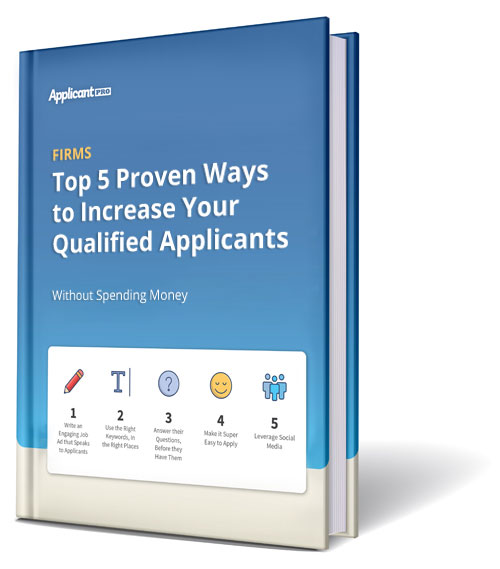
Follow a Proven Plan to Recruit During This Talent Shortage
We are now a few months into 2023, one fact I think we can all agree on is that the talent shortage is real; it's here to stay; and it's getting worse by the month.
We have been hearing over and over that there just aren’t enough people looking for work out there. Unemployment is extremely low. A lot of businesses are hiring. We’re in the midst of an economic downturn and employees just aren’t looking to leave their current jobs.
Over the last few months we have pulled data on job opening growth versus unemployment rates month over month, and looked at the gap (meaning the difference between the number of unemployed people versus the number of jobs that are open now)...here is what we’re seeing…
The job supply vs job seeker demand balance is off…
Like way off!
While the jobs that are open today are most likely not going to be filled just by unemployed people… The fact is, without more talented people being added into the active labor market, there will continue to be a talent shortage, and job seekers will continue to play musical chairs.
In the last year or so, most industries have been struggling from a lack of available talent so they’ve started to recruit from their competitors by…
using their ads,
paying sign-on bonuses,
Offering flexible and remote positions,
which leaves an opening with their competitors. Those competitors then recruit from others, and the cycle goes on and on until it comes back around resulting in the first company losing the new talent they just hired!
The issue isn't unemployment, per se
The issue is the lack of available talented people to fill the roles that an employer has, and the lack of new talented people coming into the labor market in those areas.
The gap is growing and ranges from anywhere between 2x as bad as pre-COVID to as much as 5x as bad. Whether it is general unemployment, youth unemployment, professional unemployment, blue-collar unemployment, health care unemployment, etc. The same thing is happening in the metrics.
The gap is widening.
Simply put, most people just don't think there is a lot of hope.
Recruiting is just like a game of musical chairs…
Think about the game of musical chairs…
If each chair is a job, and the people running around the circle are the workers, there are fewer workers than jobs. Meaning, there are fewer players than chairs, so there isn’t a whole lot of motivation for people to rush to get a chair. In a normal labor market, we assume that there are enough people inside the market for the chairs available. At least, as it shifts between the two, we see changes between the job seeker market and an employer market.
But, in order for the game to work, the number of new people entering the game has to be greater than the number of people leaving the game. Especially when new chairs (jobs) are being generated! This is the piece of the game that is broken in the job market and is causing chaos in almost every single industry.
So, why is the labor market “broken”?
There are a variety of reasons for this. Talented people left a lot of these jobs because…
of COVID…
They retired early…
They moved to a new part of the country…
They went back to school…
They found new opportunities in the gig economy…
Some left their old industry for a new one, and
Some had a major reassessment of their work-life priorities (a huge segment of the workforce did this).
All of these people left your game of musical chairs.
And, the new people coming into the labor market have slowed down as well. For a lot of talented people, they've reassessed what they want to do with their life, and what type of jobs they’re interested in.
Most employers don't know what to do about this problem.
We know what it's like to have your team feeling stuck and unable to solve this problem. Especially feeling like the limited options that you do have to solve for it, involve throwing money at it. And, maybe even that isn't working.
However, over the last year, we, at ApplicantPro, have grown from 140 to over 260 employees.
We want to share with you how we did this, and how your firm can do it too!
The most important thing you can do before you start making changes is to stop and assess your current situation, future needs, and how prepared you are to adapt. Let’s break each of these down:
Step one… Assess your current situation.
Look at how things are going from the last quarter versus the quarter before, or compare it to the rest of 2022. Ask yourself…
- Do you have more job openings than before?
- Have you been posting your ads in more places?
- Have you spent more on ads?
- Have you increased sign-on bonuses, compensations, improved benefits, etc?
- Have you increased your employee referral payout?
- Have you increased your use of third-party staffing recruiters?
This is really just assessing whether your needs have gone up, and whether or not you’re doing more to adapt to those needs.
Now, let’s look at your indicators…
- Are you getting fewer applicants than normal?
- Are those applicants of lower quality, or less talented?
- Are you getting less engaged applicants (ghosting on interviews or rejecting our job offers)?
You want to think about this per job opening, not just the overall number of applicants and quality of talent. And, in answering these questions, you may find that…
-You have more needs,
-You’ve done more to try to solve for it,
-And, you’re still seeing worse results.
Now, I’m willing to bet you're already starting to feel the indicators of it…. It’s taking longer to fill jobs, it's costing you more for each hire, and maybe your turnover has increased.
This probably isn't a happy set of questions to ask, but it will at least give you some level of measurement of the current talent struggle you're facing today.
And the real question to ask yourself is…
Based on what you’re doing today, did things get worse, stay the same, or get better compared to the end of last year?
What was your trend as you’re starting the year? Because that's what we want to focus on next.
Step two… Assess your future needs
Just stop for a moment and think about your organizational changes for 2023.
Now, I know you're not going to have perfect data on this, but that’s fine. All you want to do is measure this like a T-shirt size (small, medium, large, extra-large). So just think about what changes or needs are going to happen this year.
Is your organization going to increase its headcount? Either because of new locations, new initiatives, or the growth of the company?
Do you project that turnover is going to increase based on the competition in your industry for that talent? Think about how competitive you are versus other firms out there.
- Are your ads going to get more competitive and unique versus your competitors?
- Are your competitors going to start making changes?
- Is your differentiation going to be as strong or less strong versus your competitors as it was last year?
- Are you going to increase your pay/benefits, change or improve your work experience versus your competitors?
- Is your aggressiveness with your recruiting process going to stay the same as your competitors, get worse than them, or better?
Finally, think about how you estimate the indicators of what’s going to happen within your industry and roles.
- Do you think there's going to be an influx of people entering that industrial role?
- Do you think that there will be an increase in people leaving the industrial role?
- Do you feel like there's going to be more demand for hires in that industry because of the overall growth of the industry? Whether it's location increases, new initiatives going on with your competitors or new companies opening in the market?
Answering these questions will help you get a feel for how you think the rest of this year will be versus where you are right now.
Do you feel like you're going to fall further behind in filling roles with talent of any kind, stay about the same level of struggle, or do you think it's going to get easier?
Now that you’ve assessed where you are at right now, and what additional increase or decrease of struggle or needs is going to happen throughout this year, you can ask yourselves some hard questions to rate your ability as an organization to solve it.
Step three… Assess your recruiting strategy
You need to be honest, and rate how well prepared you feel your team and your firm are to meet the talent challenges you'll be facing this year, to deal with your current struggles starting on day one, as well as to overcome and compensate for how much harder things are going to get throughout the year.
Ask yourself these questions…
Do you have a solid recruitment strategy?
- Are you going to keep doing the same things that you’re doing today?
- Are you going to do something new?
- If you’re going to do something new, are you just making some small adjustments, or do you need some major initiatives to make things change?
- Do you feel that you have a recruitment strategy that's been proven to work?
Will this recruitment strategy be enough to solve your talent shortage? What you want to know is, will it provide you with enough, or more than enough, talent for your needs?
Do you know the steps needed to execute your recruitment strategy?
- Do you know the tactics that are required to accomplish the recruitment strategy that you’re putting out there?
- Are you just kind of winging it?
- Or, do you have a team that has successfully done it before?
Step four… Assess your recruiting bandwidth
Now that you understand your recruitment strategy, how prepared is your organization to execute it?
Do you have the tools and software necessary?
It’s possible that you don't have any sourcing tools outside of maybe an applicant tracking system that feeds the job boards. So you have to ask yourself, do you have an ATS? If you have a great ATS, does it do something more than just job boards?
When it comes to tools, do you have an approach and software that will help with outbound passive applicant engagement, cold emails, building talent, communities, or direct messaging?
Do you have tools in place and a strategy to go with the tools to drive an outbound strategy?
Most importantly, do you have a platform to track, manage and drive referrals coming from employees, customers, and influencers?
Again, if you don't have anything, you're not alone!
Do you have the budget that is required?
A lot of times the organization puts out the requirements for how much growth is going to happen without understanding that the budget is going to constrain it. So, are you planning on increasing your budget on a per-hire basis or are you planning to increase your job budget on a per-job basis?
Finally, do you have the time and people required?
- Are you planning on increasing the size of your recruiting team?
- Are you planning to increase the knowledge of your recruiting team?
- Are you planning to bring in people with new skills and knowledge?
- And are you planning to use your marketing team to rewrite your ads or help you with some of the messaging that's going out?
If your team isn't big enough, then you might be looking to augment your recruiting team with side services. So there are three main questions here.
- Are you planning to use temporary staffing agencies?
- Are you going to use third-party recruiters or headhunters?
- And then finally, are you looking for a recruitment marketing agency of some type that will come in and help you execute a recruitment strategy?
Recognize where you’re at
Sometimes the most important first step in solving a problem is recognizing exactly where you’re at to begin with. That sometimes isn't the happiest conversation to have with yourself, or with your team. You have to recognize just how bad the recruitment pain is, how much worse you expect it will get in the future, and maybe just how unprepared you are to solve that talent shortage problem.
But this is a crucial, necessary assessment to course-correct as early as possible.
I’ve put all of this together in a free, easy-to-use PDF tool. Download my Recruiting Self Assessment to help your organization assess…
How much hiring pain are you currently feeling?
How much harder do you project it’s going to get in the future?
How prepared is your team and organization to solve these recruitment problems?
Think about this ranging from:
“I’m scared we'll get even further behind.” TO
“I'm confident we'll be able to improve versus our competitors.”
If you have any questions as you're going through this audit for yourself, click the button below to set up a time to chat! We’d love to spend some time with your team talking through exactly what your needs are.

Boost Your Applicant Flow Today!

Hiring for your accounting firm? Here's what you need to know
Whether you have open positions to fill now, or plan to in the future, in this blog we'll explain why you should start the hiring process now and provide you with the 3 steps to approaching hiring the right way!

Looking to change your hiring software? Here's what you should know
There's a handful of common mistakes companies make when looking to change ATS providers to an end-to-end hiring vendor. If you're looking to make the change, check out these helpful tips!